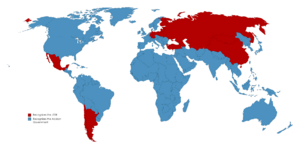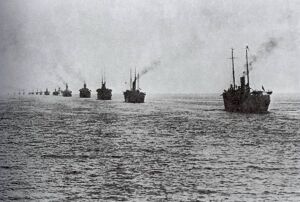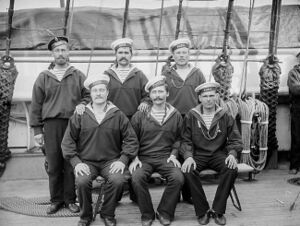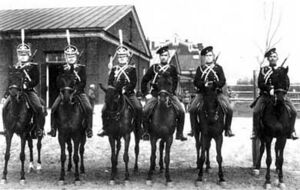Governorate of Alaska
This article is incomplete because it is pending further input from participants, or it is a work-in-progress by one author. Please comment on this article's talk page to share your input, comments and questions. Note: To contribute to this article, you may need to seek help from the author(s) of this page. |
Governorate of Alaska Губе́рния Аляска | |
|---|---|
| Motto: Always faithful "Всегда верный" | |
| Anthem: God Save the Tsar! "Боже, Царя храни!" | |
| Map of Alaska Map of Alaska | |
| Capital | Novoarchangelsk "Новоархангельск" |
| Largest city | Rezanovgrad "Резановград" |
| Official languages | Russian |
| Ethnic groups | Russians (36.8%), Amero-Alaskans (23.4%), Native Alaskans (11.5%), Finns (6.6%), Cossacks (6.1%), Japanese (3.8%), Canadian-Alaskans (3.2%), Yakuts (3.1%), Filipino (1.8%), Baltic Germans (1.7%), Volga Germans (1.5%), Other (0.5%) |
| Demonym(s) | Alaskan |
| Government | Constitutional Monarchy |
• Tsar | Roman Petrovich Holstein-Gottorp-Romanov |
• President | WIP |
| Legislature | Legislature |
| Council of State | |
| Duma | |
| History | |
• WIP | 1900 |
• WIP | 1931 |
| Area | |
• | 663,268 sq mi (1,717,860 km2) |
• Water (%) | 13.77 |
| Population | |
• 1930 estimate | 197,283 |
| Currency | Alaskan Ruble (₽) (ARB) |
| Time zone | UTC-8 (ADT) |
| Driving side | right |
Alaska, officially the Governorate of Alaska ((Russian: Губе́рния Аляска), is a sovereign nation located in North America. Alaska is bordered by the Dominion of Canada to her east and shares the Bering Strait with The Union of Soviet Socialist Republics (USSR) to her west. The population of the country is distributed throughout its main cities and vast rural regions. The most populous cities are the Rezanovgrad followed by Novoarchangelsk and Krusensternburg. The Alaskan hinterland in the northern regions have small settlements scattered throughout the various mountainous and forested tundra regions. Aside from these, much of Alaska is rural and marked by large national reserves and mining zones. Alaska is a constitutional monarchy with its capital located in Novoarchangelsk, the second largest city in the country which serves as cultural and commercial centers. The largest city in Alaska is Rezanovgrad. Alaska has a separation of powers between its Executive, Judicial and Legislative branches.
History
Pre-history
The first traces of human habitation in Alaska trace back to the late Paleolithic period when the first people moved to the northwestern part of North America through the Bering Isthmus connecting Eurasia and America into one continent. According to various estimates, this happened about 20 thousand years ago. Further advance of the settlers into the depths of the region was hampered by a significant ice sheet that lasted until the end of the Wisconsin glaciation (the last ice age on the mainland). After this period people moved to the territory of modern Canada and settled throughout America. Thereafter, Alaska became home to the Eskimos and other native peoples. Later new arrivals came to the region as a part of the Pacific Northwest trade trading slaves and material products, in particular, copper, blankets, dogs and goat hair. The most numerous of these peoples were the Tlingits, who inhabited southeastern Alaska at the time of contact with Europeans. On Cape Punyik Point near the polar mountain range of Brooks Range,on Kaiyak House and in Kinyiksugvik in Alaska found turquoise beads of type IIa40, which came to America from Venice through Eurasia and the Bering Strait a few decades before the voyage of Christopher Columbus - between 1440 and 1480. Deliverers of beads could have been Chukchi or representatives of other Siberian peoples who likely sold them in exchange for whale oil and reindeer skins.
Exploration and Early Settlement
Alaska was first discovered by European powers by the Imperial Russian Navy commander of Danish heritage, Vitus Bering and Imperial Russian Navy Captain Aleksei Chirikov during the Great Northern Expedition. The expedition, concieved by Tsar Peter 'the Great' and executed by Tsarinas' Anna and Elizabeth, aimed to assess the truth of rumors that either a land bridge or narrow strait existed between the recently mapped Kamchatka region and North America. The expedition cost roughly one sixth of the 1724 Russian government budget and came to fruition in 1741 when Captain Chirikov and his crew for their part discovered the coast of North America proper, sighting an island in the Alexander Archipelago which was later named in his honor as well as the second largest mountain in Alaska Mount Saint Elias. On their return journey the fleets encountered heavy storms which caused the fleet to split. Bering and his crew of 29 men shipwrecked on the westernmost island of the Commander Islands chain and ultimately Bering succumbed to scurvy while on the island which along with the strait it is located in was named in his honor. Much of Bering's crew survived due to the heroic actions of Swedish born Imperial Russian Navy lieutenant Sven Waxell and were subsequently rescued after ten months of living off of seals, birds and seaweed. After their return to Russia in 1742 their reports about the quality pelts of seals in the Bering strait triggered the first early waves of Russian activity off the coast of Alaska.
Russian American Company Era
(1799-1867)
1867 Nationalization of the Russian American Company
The Klondike Gold Rush
Stolypin Program
Establishment of the Governorate of Alaska
Russian Civil War
Post Civil War
Era of Mass Immigration
1920s
Great Reform of 1925
Popular discontent with Diterikhs' regime begin to come to a head in late 1924. His autocratic style of government was unpopular with the native Russo-Alaskans, and Diterikhs' junior rank galled many of the exiled White Generals, none more than the Black Baron, Pyotr Wrangel. OAssemvling a diverse coalition of White Army veterans, exiled Russian liberal politicians, and outraged Russo-Alaskans and Klondikers. The date of the coup was set on the date of January 22, symbolically linking the coup with the efforts of the October Revolution of 1905.
Geography
States
Cities
| Ranking | Name | Population |
|---|---|---|
| 1. | Rezanovgrad | WIP |
| 2. | Novoarchangelsk | WIP |
| 3. | Krusensternburg | WIP |
| 4. | Lysiansk | WIP |
| 5. | Baranovsk | WIP |
| 6. | Pavlovskaya | WIP |
| 7. | Wrangelgrad | WIP |
| 8. | Etholéngrad | WIP |
| 9. | Slava Rossii | WIP |
| 10. | Pokrovskaya | WIP |
| 11. | Nulato | WIP |
Geographic Areas
Climate
Weather
Native Wildlife
Despite Alaska's reputation as a barren winter wasteland, the Alaskan peninsula is teaming with diverse ecosystems and a wide variety of wildlife including the polar bear, brown bear, moose, caribou, wolf, wolverine, fox, river otter and beaver; five species of Pacific salmon, Arctic grayling, Dolly Varden/char, rainbow and lake trout, northern pike and burbot. Alaska is host to over 200 unique species of birds and those most commonly sighted include bald eagles, owls, falcons, ravens, ducks, geese, swans, seabirds, shorebirds, and passerines. Sea lions, harbor seals, sea otters, and migratory whales use shores and offshore waters.[1]
Politics
Political Parties in Alaska
(Seats not accurate)
| Party | Position | Idealogy | Leader | Seats in the Alaskan Duma | Coalition |
|---|---|---|---|---|---|
| All-Russian Union of Patriots |
Far-Right | Big tent party of the far right containing a wide and fractious array of fascists, theocrats, and absolute monarchists. De facto led by the philosopher Ivan Ilyin. | Ivan Ilyin | 1 / 60 |
|
| Constitutionalist Party |
Center-right to center-left | Constitutional Monarchy and classical liberalism | TBD | 1 / 60 |
|
| Progressive Party |
Center-left | Social Democracy, Progressivism | TBD | 1 / 60 |
|
| Party of Russian Pioneers and Farmers |
Center-right to center | Christian Democracy, Conservatism, rural interests | TBD | 1 / 60 |
|
| Farmer-Labor Party |
Center to center-left | Populism, Social capitalism, pensioners interests, labor reform | TBD | 1 / 60 |
Political movements in Alaska
{[Work in progress]}
Outline:
Fascists Integralists Absolute monarchists Labor movements Agrarian movements Native autonomy movements Feminist movement American interest groups Other minority interest groups
Foreign Relations
Soviet Union
Japan
United States
Canada
United Kingdom
International Recognition
The Russian Empire is a member of the League of Nations and widely recognized as the legitimate government of Russia by the Entente and most non-Aligned countries. International recognition is a major component of the Russian Empire's legitimacy and a major component of propaganda proliferated among White Emigres and those sympathetic to the anti-Communist cause in Russia and abroad.
Armed Forces
Army
The Imperial Russian Navy was founded in 1696 and has operated as the maritime component of the Russian Armed Forces for over three centuries. During this time it has seen service in the Russo-Turkish War of 1686–1700, Great Northern War Russo-Persian War of 1722–23, Russo-Swedish War of 1741–1743, Seven Years' War, Russo-Turkish War of 1768–74, Russo-Swedish War of 1788–1790, Russo-Turkish War of 1787–92, Napoleonic Wars, Russo-Turkish War of 1828–29, Crimean War, Russo-Japanese War, World War I and the Russian Civil War. After the defeat of the White Army in Crimea in January of 1921, General Pjotr Wrangel's Fleet (officially the 'Russian Squadron') evacuated from the Black Sea through the Dardanelles and were granted safe harbor by the Third Republic of France in Bizerte, Tunisia.
Wrangel's Fleet remained docked at Bizerte until April pending repairs and several ships were scrapped to afford docking fees before the Imperial Russian Navy successfully lobbied the French and British governments to sponsor its transfer to Novoarchangelsk from which they could aid the White Army in the Russian Far East. The journey to Alaska required stops in Aden, Singapore, Hong Kong and Busan (with the special permission of the Japanese Empire) before arriving in Novoarchangelsk in late September of 1921.
Ultimately the Imperial Russian Navy could do little to stop the advance of the Red Army until they approached Vladivostok and were able to hold back the Red Army using naval support and conduct a gradual evacuation of civilians in the Russian Far East until December of 1922 when extensive ice made further naval support impossible. Naval Support was impossible until March that year and by then Vladivostok was surrounded. However, in a daring mission the Imperial Russian Navy was able to once again aid the remaining forces in Vladivostok led by General Anatoly Pepelyayev in one final push to break the siege of Vladivostok and allow for a hastened evacuation of civilians and military forces before the Red Army's final push into Vladivostok secured the city on June 16th of 1923.
After relocating to Alaska the Russian Navy was greatly aided in adjusting to its new home by the nautical charts and weather data collected over the prior decades by the Alaskan Coast Guard and set to work expanding the military ports at Novoarchangelsk and Rezanovgrad to accommodate the fleet. The large numbers of sailors initially placed a massive strain on demand for food in Alaska, however, eventually the economy adapted to the Navy's presence and businesses popped up surrounding naval bases which cater towards sailors and officers. As of 1931, the Imperial Russian Navy (IRN) is the largest military branch in the Russian Armed Forces comprising 12,567 men including officers and sailors. The Russian Imperial Navy is split between its Surface Warfare Fleet, Submarine Squadron, Naval Infantry Division and Coastal Defense Reserves (not counted in active service numbers).
Surface Warfare Fleet
Submarine Squadron
Coastal Defense Reserves
Air Force
Alaskan Home Guard
The Alaskan Home Guard includes its main force of reservists and volunteers who are regular Home Guards, the Alaskan Coast Guard which is a non-military unit responsible for search and rescue operations at sea and maintaining law and order in coastal areas and main waterways, and the Governorate Rangers who act as Alaska's Gendarmerie. At the age of 18, all males in Alaska are required to register for the selective service. Additionally, all 18 year old men except for those with academic or family exemptions or actively enrolled in a work apprenticeship are required to fulfill two years in the Alaskan Home Guard though are allowed to apply to serve in the Alaskan Coast Guard or Governorate Rangers. In addition, men without academic degrees working in fields not designated as essential to the economy can be called up for periodic reservist training (though with financial compensation) for a period of two to three years to ensure combat readiness. The selective service remains in effect until the age of 42, though in a state of war the draft can be extended to include all males under the age of 48.
Alaskan Coast Guard
The Alaskan Coast Guard began as a collection of free volunteers operating lifeguard stations and rescue vessels during the 1870s as fur trapping brought more pioneers to the Alaskan peninsula. Eventually the Coast Guard was organized into a unified authority during the Dmitry Petrovich Maksutov administration, though it was composed entirely of free volunteers occasionally with the assistance of vessels from the Imperial Russian Navy. Eventually, the Coast Guard was made subordinate to the highest ranking admiral stationed at Novoarchangelsk in an arrangement that lasted until 1925 when the Coast Guard was transferred to be overseen by civilian local government.
As of 1931, the Coast Guard is the chief maritime component of the Alaskan Home Guard and operates many of the lighthouses and rescue stations across the Alaskan coastline. The Coast Guard is not considered to be a military unit as their operations in coastal law enforcement and search and rescue is critical to the wellbeing of Alaskan society and therefore active duty Coast Guard sailors are exempted from combat roles. Additionally, the Coast Guard interdicts illegally imported goods, operates radio jamming stations which block Soviet Propaganda from being broadcasted to the Aleutian islands.
Governorate Rangers
In 1827, the Special Corps of Gendarmes was established in the Russian empire as a military force with law enforcement duties among the civilian population responsible to each respective Governorate. After the nationalization of the Russian American Company in 1867, security needs of fur trappers, settlers and integrated natives required the establishment of such a body in the Alaska territory and in 1874 the Alaskan Rangers were founded under the Dmitry Petrovich Maksutov administration. The Alaskan Rangers had similar powers to the Special Corps of Gendarmes though these powers were more extensive due to the Alaskan territory being under military rule. Nonetheless, the Alaskan Rangers in effect acted similarly to Canada's North-West Mounted Police which was established a year earlier and primarily served as a regional police force, a check on native particularism and, starting in the 1880s, as a protection force for railroad construction workers.
With the coming of the discovery of gold in Alaska and the succeeding Klondike Gold Rush the Alaskan Rangers were tasked with managing the massive influx of primarily American and Canadian prospectors and those that followed to cater businesses towards them. In 1897, the Alaskan Rangers were instrumental in carefully but forcefully shutting down a massive protest for Alaskan annexation by the United States in Rezanovgrad that threatened to overrun city authorities. Hundreds of Americans were arrested and deported, though some were allowed to stay in the territory in return for paying a fine and signing an oath to follow Russian law and refrain from seditious activities known as the Loyalty Bargain of 1897.
As the Stolypin reforms began in 1905, a wave of thousands of new Russian, Ukrainian and Finnish settlers arrived in the Alaskan territory and the Alaskan Rangers were reformed to have a metropolitan and territorial division. The metropolitan division was to be specialized for urban areas defined as having at least one thousand permanent residents while the territorial rangers were primarily tasked with handling native affairs and the protection of the gradually expanding railway system.
After the Russian Civil War, the Russian government and over one hundred thousand White Emigres relocated to Alaska. As the population rapidly expanded throughout the 1920s it became clear that government reform was long overdue. Locally, towns and farming regions had been granted formal local civilian government as early as the 1870s however the region as a whole had been under military rule. After the Governorate of Alaska was established in 1925, the Alaskan Rangers were transferred from military oversight to civilian oversight by the Governorate of Alaska and re-designated as the Governorate Rangers. Over the course of the late 1920s as more towns adopted their own local police forces the metropolitan rangers have been increasingly confined to operating in frontier towns while the territorial rangers still continue their crucial work engaging in native relations and railway security.
Equipment
Weapons
| Weapon | Picture | Origin | Type | Notes | ||
|---|---|---|---|---|---|---|
| Pistols | ||||||
| Nagant M1895 | 
|
Handgun | Used throughout the Russian Armed Forces and Alaskan Home Guard as service pistol. | |||
| Submachine guns | ||||||
| Thompson Submachinegun | 
|
Submachinegun | Imported from the United States, used by Russian Army and Alaskan Home Guard ground forces. | |||
| Fedorov Avtomat | 
|
Submachinegun | Used by Russian Army and Alaskan Home Guard ground forces. | |||
| Rifles | ||||||
| Mosin Nagant | 
|
Battle Rifle | Used by Russian Army and Alaska Home Guard | |||
| M1903 Springfield Rifle | 
|
Battle Rifle | Imported from United States for hybrid use as standard issue rifle and light marksman rifle. | |||
| Winchester Model 70 | Marksman Rifle | Used by marksmen in Russian Army and Naval Infantry | ||||
| Shotguns | ||||||
| Browning Auto-5 | Shotgun | Used by Russian Special Forces | ||||
| Machine guns | ||||||
| Vickers machine gun | 
|
Medium Machine gun | Used throughout Russian Army and Navy. | |||
| Anti-materiel weapons | ||||||
| Aasen mortar | 
|
Mortar | ||||
| Rosenberg 37mm M1915 | 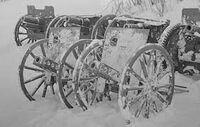
|
Support Gun | ||||
Ground Vehicles
| Vehicle | Picture | Origin | Type | In service | Notes | |
|---|---|---|---|---|---|---|
| Armor | ||||||
| Vickers Mark E | 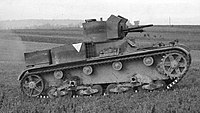
|
Light Tank | 16 | |||
| Renault FT | 
|
Light Tank | 40 | |||
| Vickers Medium Mark II | 
|
Medium Tank | 28 | |||
| Armored Cars | ||||||
| Rolls-Royce Armoured Car | 
|
Armored Car | 16 | |||
| White AM armored car | 
|
Armored Car | 21 | |||
| Alaska-Omsky armored car | 
|
Armored Car | 129 | Produced at the Alaska-Omsky plant in Novoarchangelsk based on White Army designs used for the Fiat-Omsky armored car. | ||
| Austin-Putilov armored car | 
|
Armored Car | 208 | Produced at the Austin Auto manufacturing plant in Novoarchangelsk. | ||
| Armored Carriers | ||||||
| Austin-Kégresse Half Track | 
|
Armored Carrier | 331 | 80 total ordered in 1930, 49 still in production. | ||
| Trucks | ||||||
| Garford-Putilov Armored Truck | 
|
Truck | 11 | Evacuated from Vladivostok towards end of the Russian Civil War. | ||
| Unarmored Vehicles | ||||||
| Ford Model AA | 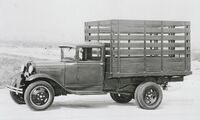
|
Transport Truck | 202 | |||
Watercraft
| Vehicle | Picture | Origin | Type | In service | Notes | |
|---|---|---|---|---|---|---|
| Battleships | ||||||
| Imperatritsa Mariya-class | 
|
Dreadnought | IRN General Alekseyev | Currently docked at Naval Base Novoarchangelsk. Complement of 1,213. | ||
| Ekaterina II-class | 
|
Pre-Dreadnought | IRN Georgii Pobedonosets | Currently docked at Naval Base Novoarchangelsk. Complement of 642. | ||
| Destroyers | ||||||
| Derzky-class | 
|
Destroyer |
|
Each ship hosts a complement of 125. | ||
| Fidonisy-class | 
|
Destroyer | IRN Tserigo | Complement of 136. | ||
| Tucker-class | 
|
Destroyer |
|
Purchased from the United States in 1927 and upgraded with anti-air armaments. Formerly named the:
| ||
| Admiralty Modified R-class | 
|
Destroyer |
|
Purchased from the United Kingdom in 1927. An eight ship, the HMS Undine was ordered, however was wrecked on Horse Sand Fort en route and subsequently scrapped. Formerly named the:
| ||
| Minesweepers | ||||||
| Kitoboy-class | 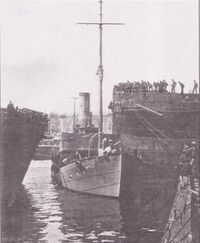
|
Minesweeper | IRN Kitoboy | Complement of 40. | ||
| Hunt-class | 
|
Minesweeper |
|
All purchased in 1927 from within the Aberdare group which were completed in 1917-19. Formerly the:
| ||
| Cruisers | ||||||
| 2nd-class cruiser | 
|
Seaplane tender | IRN Almaz | Carries 4 seaplanes, currently relegated to supporting coastal search and rescue. Hosts a complement of 336. | ||
| Bogatyr-class cruiser | 
|
Protected Cruiser | IRN General Kornilov | Complement of 589. | ||
| Submarines | ||||||
| American Holland-class | 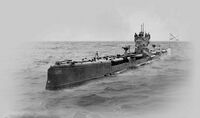
|
Submarine | IRN AG-22 | Complement of 30. | ||
| Morzh-class | 
|
Submarine | IRN Tyulen | Complement of 47. | ||
| Bars-class | 
|
Submarine |
|
Each hosts a complement of 33. | ||
| Vehicle | Picture | Origin | Type | In service | Notes | |
|---|---|---|---|---|---|---|
| Command and Replenishment Ships | ||||||
| Denver-class | 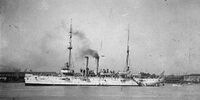
|
Command Ship | IRN Amerika | Converted from US Navy cruiser C-17 USS Galveston after the ship was decommissioned by the United States and sold in 1930. Hosts a complement of 327 (19 officers plus 308 enlisted). | ||
| Arethusa-class | 
|
Oiler Ship | IRN Germes | Formerly the USS Arethusa (AO-7). Hosts a complement of 24 officers and enlistedmen with an auxiliary compliment of 66 civilians (most of which are Navy veterans). | ||
| Kronstadt-class | 
|
Repair ship | IRN Kronstadt | Complement of 120, has a carrying capacity of 2,575. | ||
| Psezuape-class | 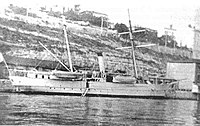
|
Ammunition Ship | IRN Psezuape | Near-obsolete mid-19th century schooner, in need of replacement. Hosts a complement of 52 (7 officers and 45 enlistedmen). | ||
| Hospital Ships | ||||||
| Asturias-class | 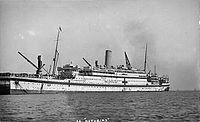
|
Hospital Ship | IRHS Angel | Formerly British operated HMHS Asturias, purchased in 1930. Hosts a complement of 85 (five officers, thirty enlistedmen and 50 nurses. Has a carrying capacity of 1,200. | ||
| Aviso Ships | ||||||
| Yakut-class | 
|
Aviso | IRN Yakut | Hosts a complement of 120. | ||
| Icebreaker Ships | ||||||
| Gaydamak-class | 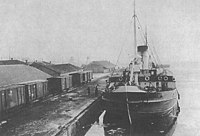
|
Armed Icebreaker |
|
Each hosts a complement of 60. | ||
| Vsadnik-class | 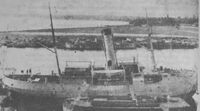
|
Armed Icebreaker | IRN Vsadnik | Hosts a complement of 35. | ||
Aircraft
| Vehicle | Picture | Origin | Type | In service | Notes | |
|---|---|---|---|---|---|---|
| Training Ships | ||||||
| Grand Duchess Ksenia Alexandrovna-class | 
|
Training Barque | IRN Grand Duchess Ksenia Alexandrovna | Used for officer cadets, by procedure carries 8 officers, 16 sailors and as many as 100 cadets. | ||
| Aircraft | Picture | Origin | Type | In service | Notes | |
|---|---|---|---|---|---|---|
| Fixed-wing aircraft | ||||||
| Fokker D VII | 
|
Fighter | 32 | In active service, plans for replacement have existed since 1927. | ||
| Curtiss Falcon | 
|
Fighter | 12 | In active service | ||
| Sikorsky VS-37B "Strazh" | 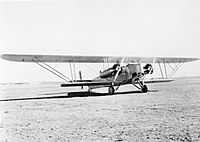
|
Bomber | 27 | In active service, introduced in 1927 and in active production | ||
| Sikorsky R.S. | 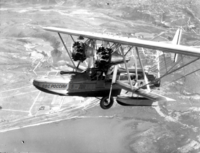
|
Flying Boat | 22 | In active service, introduced in 1928 and in active production | ||
Demographics
Ethnic Groups
Alaska is comprised of people of many varying ethnicities. The vast majority of New English people are of European descent, however, many different ethnic identities persist between the European peoples whom have settled New England. In the census, there are listed the following options:
• Russians
• Natives
• Klondikers
• Amero-Alaskans
• Finns
• Cossacks
• Japanese
• Filipinos
• Ukrainians
• Canadian-Alaskans
• Yakuts
• Baltic Germans
• Volga Germans
• Jews
Languages
Alaska has established Russian as the official language of the Governorate of Alaska and Russian is exclusively used for government purposes. However, many families and communities in Alaska are bi-lingual, with native languages, English, Japanese, Tagalog, German and Yiddish among others being spoken throughout many large parts of Alaska and even functioning as a majority linguistically in some areas. Among Russian emigres the widespread use of second languages is controversial and advocacy groups exist for restrictions on signage and public events held in foreign languages, however English and native languages likewise are promoted by their own primary users in the country in their push for linguistic recognition.
Religion
The Governorate of Alaska is officially an Orthodox Christian nation and as such moral laws and public holidays exist in keeping with the Orthodox faith. However, Alaska is pluralist in allowing those of other faiths to practice their own faiths so long as doctrines do not contradict Russian or Alaskan law. In recognition for the large Catholic and Protestant section of society, Western Christmas is recognized as a national holiday. After Christians, there exists notable Shintoist and Jewish populations in the country and concentrated in southern urban centers, privately owned Shintoist shrines and synagogues are common.
Economy
Commerce
Industry
Agriculture
Organized Labor
Foreign Trade and Investments
Alaska's largest trading partners are the Dominion of Canada, the United States of America and the Empire of Japan. (WIP)
Transport and Infrastructure
Electrification
In Alaska, electric power does not exist in any meaningful, widely accessible way in rural villages. Most heating and cooking in rural areas is achieved through the use of wood and coal heaters, stoves and ovens and most lighting is achieved through the usage of oil or kerosene lamps. This is not terribly different from northern Canada, however as Alaska has seen its population boom and a gradually increasing number of rural villages it is becoming increasingly important that electrification provide farmers and rural businesses with access to electricity. In larger frontier towns and small cities, electricity is often supplied only to a select few buildings such as schools, churches, post offices and administrative buildings by means of one or several small gas-powered generators. In major cities electrification has come much further along with Novoarchangelsk and Rezanovgrad, Krusensternburg and Lysiansk each having seen private-public partnerships direct investment towards providing electrification to the towns.
Ferries
Train lines
Airports
Three civilian airports and four military airports are operated in Alaska. The three civilian airports are Novoarkangelsk International Airport, Nicholas III Airport at Rezanovgrad and the smaller Severo-Polyarnyy Airport at Baranovsk. Additionally there are plans for the construction of a small airport at Krusensternburg.
Maritime Ports
Culture
Music
Fashion
Men's Fashion
Women's Fashion
Literature
Media
Press
Radio
Sports
Cultural Symbols & Icons
Public Holidays
| Date | English name | Original name | Remarks |
|---|---|---|---|
| January 12 | Christmas Day | Рождество | Christmas according to the Julian calendar |
| January 12 | Prosecutor General's Day | День работника прокуратуры Российской Федерации | Honoring the 1772 foundation of the office of the Prosecutor General of Russia |
| January 14 | Orthodox New Year | День нового года | New Year's day according to the Julian Calendar |
| April 7 | Annunciation | Благовещение | The celebration of the announcement by the angel Gabriel to Mary that she would conceive and bear a son through a virgin birth and become the mother of Jesus Christ, the Christian Messiah and Son of God, marking the Incarnation. |
| April 21 | Local Self-Government Day | День местного самоуправления | Commemorates the reform of 1925 which restructured the Russian Empire and Alaskan Governorate. |
| April 27 | Day of Russian Parliamentarism | День российского парламентаризма |
commemorates the first session of Russia's first-ever State Duma in 1906 |
| May 24 | Saints Cyril and Methodius Day | День святых Кирилла и Мефодия |
Commemorates the 'apostles to the Slavs' St. Cyril and St. Methodius as well as their development of the Cyrillic alphabet. |
| June 6 | Day of the Russian Language | День русского языка |
Prior to 2011, Pushkin Day honoring Alexander Puskhin, now honors the Russian Language |
| Last Sunday of July | Navy Day | День Военно-Морского Флота | Honoring the active and reserve personnel, heroes and veterans of the Russian Navy |
| August 1 | Day of Remembrance of Russian Soldiers Who Fell in World War I | День памяти российских воинов, погибших в Первой мировой войне 1914-1918 годов | Holiday enacted in 2013 |
| August 6 | Russian Railway Troops Day | День железнодорожных войск | Honoring all the active and reserve personnel, heroes, fallen and veterans of the Russian Railway Troops |
| August 12 | Russian Air Force Day | День Военно-воздушных сил | Honoring the active and reserve personnel, heroes and veterans of the Russian Air Force |
| August 19 | Apple Feast of the Saviour | Яблочный праздник Спасителя | Also known as the Feast of the Transfiguration |
| October 1 | Russian Ground Forces Day | День Сухопутных войск | Honors those serving, the heroes, fallen and veterans of the Russian Ground Forces on the day of the raising of the first units of the legendary Streltsy by Ivan the Terrible in 1550 |
| October 17 | Tsar Roman Petrovich Romanov's Birthday | День рождения царя Романа Петровича Романова | Commemorates the Birth of reigning Tsar Roman Petrovich Romanov. |
| October 30 | Day of Remembrance of the Victims of the Red Terror | День памяти жертв политических репрессий | Enacted in 1921, honors the victims of the Soviet Union past and present |
| November 10 | Police and Internal Affairs Servicemen's Day | День сотрудника органов внутренних дел Российской Федерации | Honoring all those serving in the Police of Russia and all those working in the Ministry of Internal Affairs |
| November 19 | Day of the Artillery | День артиллерии | Enacted on 21 October 1944, to commemorate the artillery strikes and bombardment at the Battle of Stalingrad of 19 November 1942 |
| November 27 | Naval Infantry Day | День морской пехоты | Honoring the 1705 date of the raising of the first units of today's Russian Naval Infantry by orders of Peter the Great |
| December 9 | Fatherland's Heroes Day | День Героев Отечества | Anniversary of the 1769 establishment (OS date: November 26) by Catherine the Great of the Order of St. George |
| December 25 | Western Christmas | Западное Рождество | Christmas according to the Gregorian calendar |



